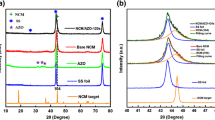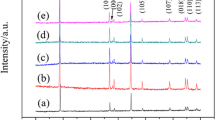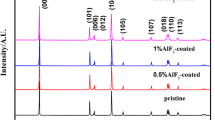Abstract
The electrochemical properties of nanoscale Al2O3-coated LiCoO2 thin films were examined as a function of the coating coverage. Al2O3-coated LiCoO2 films showed enhanced cycle-life performance with increasing degree of coating coverage, which was attributed to the suppression of Co dissolution and F− concentration in the electrolyte. Moreover, an Al2O3-coating layer with partial coverage clearly improved the electrochemical properties, even at 60 °C or with a water-contaminated electrolyte. Even though metal-oxide coating on LiCoO2 has been actively investigated, the mechanisms of nanoscale coating have yet to be clearly identified. In this article, surface analysis suggested that the Al2O3-coating layer had transformed to an AlF3 ∙3H2O layer during cycling, which inhibited the generation of HF by scavenging H2O molecules present in the electrolyte.
Similar content being viewed by others
Avoid common mistakes on your manuscript.
Introduction
Recently, hexagonal LiCoO2 cathode materials have been used in most commercial lithium-ion batteries on account of their simple preparation, high specific capacity, and good electrochemical properties [1]. However, Li x CoO2 is typically charged up to ∼4.2 V vs. Li (Li0.5CoO2), yielding a specific capacity below ∼140 mAh/g. Further increased charge cutoff voltage results in significant deteriorations of LiCoO2. This is attributed to structural changes in the unit-cell volume [2], increased cobalt dissolution into the organic electrolyte [3], loss of oxygen [4], formation of electrochemically resistive surface films [5], etc.
An effective method of resolving the problem of capacity fading at high cutoff voltage is thermal treatment [6, 7] or coating the surface of cathode with various materials (metal oxide, metal phosphate, or other materials) [8–22]. It was previously reported that a nanoscale metal-oxide coating on the surface of cathode improved the electrochemical properties at high cutoff voltages and current rates [8–13, 17–21]. Thackeray et al. reported enhanced capacity and stability in cycling by coating ZrO2 on LiMn2O4, and speculated that the enhanced performance of spinel was attributed to its ability of ZrO2 particles to neutralize the HF component from the electrolyte [23]. Myung et al. also reported that a metal-oxide coating layer on Li1.05Ni0.4Co0.15Mn0.4O2 acted as an HF scavenger, and they suggested the following reaction: Al2O3+6HF→2AlF3+3H2O [24, 25]. However, H2O generated from the reaction between Al2O3 and HF regenerates HF in the electrolyte, and the same things happen again consequently. My group reported that metal-oxide coating on LiCoO2 can affect lattice expansion during cycling [8, 9]. Some other researchers suggested that a partial or non-uniform coating still improved the electrochemical properties of powder materials [26, 27]. My group recently reported that Al2O3-coated LiCoO2 thin film with even 50% coating coverage showed enhanced cycle-life performance with no evidence of mechanisms [28], and Al2O3 coating on LiCoO2 powder was also carefully investigated by Fey et al. [29, 30]. These results were correlated with the suppression of Co dissolution during electrochemical cycling. However, the mechanisms of metal-oxide coating have yet to be clearly identified.
Characterizing the intrinsic properties of LiCoO2 powders is complicated, because the powder geometry consists of polymer binders and carbon blacks for the required electronic conduction among the ∼10 μm powders. Therefore, thin-film geometry is appropriate for investigating the intrinsic properties of nanoscale coating on LiCoO2, because it has only a cathode and metal-oxide electrolyte interface, and is insensitive to the coating thickness on cycle-life performance [10]. In this article, thin-film LiCoO2 cathodes were examined by distinctly controlling the coating coverage, cycling temperature, and level of water contamination in order to clarify the scavenge mechanisms.
Experimental section
LiCoO2 thin films were deposited on thermally oxidized Si (100) substrates using RF magnetron sputtering of a LiCoO2 target. A Pt current collector was deposited onto a TiO2 adhesion layer, and the LiCoO2 film was deposited on the Pt layer. An approximately 600-nm-thick LiCoO2 was deposited at a pressure of 20 mTorr with an Ar/O2 ratio of 3/1 after presputtering for 1 h. To obtain high-quality LiCoO2, all films were annealed at 700 °C in an oxygen atmosphere at 20 mTorr for 30 min. The 10-nm-thick Al2O3 thin films with a coating coverage ranging from 25% to 100% were deposited on top of the crystallized LiCoO2 films by reactive sputtering of an Al target. The Al2O3-coating patterns with 75%, 50%, and 25% coverage consisted of 1,000, 360, and 150 μm squares, respectively, with a distance of 150 μm between the nearest squares. After Al2O3 deposition, the coated and bare samples were heat-treated at 400 °C for 2 h in an oxygen atmosphere.
Beaker-type half cells were used to evaluate the electrochemical properties. The cells were made up of Li-metal sheets as a counter and reference electrode, a LiCoO2 cathode with an active area of ∼1 cm2 as a working electrode, and 1 M LiPF6 in ethylene carbonate/diethyl carbonate (EC/DEC, 1/1 vol.%, water impurities of less than 20 ppm) (Cheil Industries, Inc.) as the electrolyte. The cells were electrochemically cycled over the voltage range of 2.75 and 4.4 V by applying a current density of 0.4 mA/cm2 (= 12 C) at 25 °C and 60 °C. At all the charge/discharge cutoff steps, the cell voltages were potentiostated until the current decreased to 10% of the charge/discharge rate with a time limit of 10 min. The charge-transfer resistance of cathodes with the bare and coated LiCoO2 films was measured by electrochemical impedance spectroscopy (EIS) from 10 mHz to 100 kHz with an ac signal amplitude of 5 mV. The EIS was measured at a 4.2 V charged state with a current less than 1 μA/cm2, during the initial cycle, and after the tenth, 40th, and 80th cycles.
Inductively coupled plasma–mass spectroscopy was used to measure the extent of cobalt dissolution into the electrolyte, after floating the 4.6 V charged cathodes for 12 days at 25 °C. The fluorine-ion concentration in the electrolyte was measured by ion chromatography (IC, Dionex 500). The effects of water impurities on the electrochemical properties of LiCoO2 were examined by cycling the cells at 25 °C with a 200 ppm water-contaminated electrolyte. The compounds on the surface of cathode materials were examined using a time-of-flight secondary-ion mass spectroscopy (ToF-SIMS, PHI7200) surface analyzer equipped with a 7.9 keV Cs ion source and pulse-electron flooding.
Results and discussion
The electrochemical performance was examined by cycling the Al2O3-coated LiCoO2 thin films with a surface coverage ranging from 0% to 100%. Figure 1 shows the cycle-life performance of the bare and Al2O3-coated LiCoO2 films, excluding the capacity at constant-voltage mode. The Al2O3-coated LiCoO2 films show improved capacity retention with increasing coating coverage. Nonlinearity of charge and discharge capacities above 70 cycles is attributed to the slower kinetics of Li+ de-intercalation in bare LiCoO2 than Li+ intercalation, as observed by a galvanostatic intermittent titration technique, since the extra capacity from the constant-voltage mode (at 4.4 and 2.75 V) is not included [10, 15].
The voltage profiles of the bare and Al2O3-coated LiCoO2 thin films with various degrees of surface coverage (observed at 25 °C) are shown in Fig. 2. Compared with the profiles of the bare LiCoO2, a slight increase in polarization is observed in the initial cycle of the Al2O3-coated cathodes. From the second cycle, the polarization in the charge and discharge processes of the coated sample becomes less significant [10, 15].
In order to correlate the cycle-life performance of thin-film LiCoO2 with the electrode kinetics, EIS analysis of both the bare and Al2O3-coated LiCoO2 films with different degrees of surface coverage was carried out after cycling, as shown in Fig. 3. Before the EIS measurements, all cells were cycled at 0.4 mA/cm2 between 4.4 and 2.75 V, and potentiostated at 4.2 V until the current density had decreased to 1 μA/cm2. All the LiCoO2 thin films during the first cycle show similar charge-transfer resistance (R ct), indicating that R ct at the interface of the Al2O3-coating layer and LiCoO2 film is comparable to that of the electrolyte and LiCoO2 film during the initial cycle. However, R ct of the bare LiCoO2 significantly increases with increasing number of cycles compared with the coated LiCoO2 films. These impedance spectra are consistent with the cycling performance of bare and fractional Al2O3-coated LiCoO2 films, because the increase in R ct is closely related to a deterioration of the electrochemical properties of the cathode during cycling.
The effect of Al2O3-coating coverage on the HF generation was examined by measuring the F− concentration in the electrolyte. The amount of F− decreases with increasing Al2O3-coating coverage. Moreover, the Al2O3 coating with 100% coverage effectively inhibits F− generation (∼300 ppm), which is much smaller than the F− concentration (∼2,900 ppm) from the uncoated LiCoO2 samples. It was reported that the decomposition of a LiPF6-based electrolyte with water leads to the formation of HF (LiPF6→LiF+PF5 and PF5+H2O→POF3+2HF), which accompanies Co dissolution from LiCoO2 [31, 32]. The amount of Co dissolution into the electrolyte from the uncoated LiCoO2 thin film is ∼460 ppm, while that from the Al2O3-coated LiCoO2 film with 100% coverage is ∼50 ppm, as shown in Fig. 4. There is a strong correlation between the amount of Co dissolution from the Al2O3-coated LiCoO2 with different degrees of surface coverage and the charge-capacity retention after 100 cycles (shown in Fig. 1a). Although it is difficult to analyze the amount of scavenged water by the Al2O3-coating layer, the improved electrochemical properties even with partial coverage indicate an interaction between the coating layer and the electrolyte, which inhibits the HF generation by water scavenging.
The charge-capacity retention after 100 cycles from Fig. 1a, and the Co dissolution and F− concentration in the electrolyte from bare and Al2O3-coated LiCoO2 films with different coverage, after an initial 4.6 V charge and being immersed for 12 days at 25 °C
Figure 5 shows the cycle-life performance of the bare and Al2O3-coated LiCoO2 thin films with different coverage ratios at 60 °C. The Al2O3-coated LiCoO2 films with 25% coverage show rapid capacity fading after ∼70 cycles at 60 °C. However, the initial capacity and the capacity retention of the Al2O3-coated LiCoO2 at 60 °C increase with the increasing Al2O3-coating coverage. The Al2O3 coating with a coverage ranging from 50% to 100% shows excellent cycle-life performance at the elevated temperature.
The cycle-life performances of the bare and Al2O3-coated LiCoO2 films with 200 ppm water-contaminated electrolytes at 25 °C were examined as a function of the surface coverage, as shown in Fig. 6. The initial capacity and the capacity retention with water impurities increase with the increasing Al2O3-coating coverage. The Al2O3 coating even with partial coverage appears to inhibit the Co dissolution from acidic HF which occurs in the electrolyte.
In order to clarify the mechanisms of how an Al2O3 coating effectively enhances the electrochemical properties of LiCoO2 films under severe conditions, such as elevated temperature and additional water, the level of electrolyte decomposition was analyzed by measuring the amount of F− in the electrolyte. As shown in Fig. 7a, the F− concentration in the electrolyte of the Al2O3-coated LiCoO2 with full coverage samples is extremely low compared with that of the bare samples. The Al2O3 coating appears to suppress Co dissolution from LiCoO2, even at an elevated temperature and additional water impurity. This is correlated with the capacity retention of LiCoO2 as a function of the coating coverage, as shown in Fig. 7b.
a The F− concentration in the electrolyte from bare and Al2O3-coated LiCoO2 films with 100% coverage, after an initial 4.6 V charge and being immersed for 12 days at 25 °C, 60 °C, and 25 °C with 200 ppm water, respectively. b The charge-capacity retention of Al2O3-coated LiCoO2 films, after 100 cycles at 25 °C (Fig. 1), 60 °C (Fig. 5), and 25 °C with 200 ppm water (Fig. 6)
To investigate the reactions between the Al2O3 coating and electrolyte with water contamination, the surface was examined by SIMS after 60 cycles in an electrolyte containing 200 ppm of water. In Fig. 8, the marked lines indicate the calculated ratios of mass/charge for AlOF −2 (80.97 Th, Th = 1 hydrogen atomic mass/electron charge), AlF −4 (102.98 Th) and CoOH+ (75.94 Th), respectively. A fragment of CoOH+, which is attributed to cobalt dissolution from LiCoO2 was observed on the surface of the bare LiCoO2 films. However, the amount of CoOH+ on the surface decreased significantly even with a 50% Al2O3 coating, as shown in Fig. 8c.
Kleist et al. reported that bulk Al2O3 powders react with HF and H2O in an electrolyte to form AlF3 ∙3H2O complexes at room temperature after 3 days [Al2O3+6HF+3H2O→2(AlF3∙3H2O)], which was confirmed by the sharp X-ray diffraction peak widths [33]. Density-functional theory calculations also showed that AlF3 ∙3H2O complexes were energetically favorable compared to AlF3 and water, by ∼2 eV/AlF3 [34]. With these studies, the SIMS data of AlOF −2 and AlF −4 suggest that an Al2O3-coated layer scavenges H2O molecules, which improves the electrochemical properties of LiCoO2 cathodes (Fig. 9).
Conclusions
This study examined the electrochemical properties of nanoscale Al2O3-coated LiCoO2 thin films as a function of the coating coverage. These results were attributed to the suppression of Co dissolution and decomposition of LiPF6 by extensive cycling. It was found that AlF3 ∙3H2O was formed from the Al2O3-coating layer by a reaction with HF and H2O, thereby scavenging H2O molecules in the electrolyte and consequently decreasing the amount of HF. The enhanced electrochemical properties with various degrees of coating coverage were correlated with the affinity of metal fluoride to scavenge H2O impurities in the electrolyte. It still remains a question that how many H2O molecules can be scavenged by Al2O3 coating, and what the effective partial-coating thickness is. In addition, direct evidence of AlF3 ∙3H2O with reaction kinetics between Al2O3 coating layer and HF/H2O also needs to be clarified experimentally.
References
Tarascon JM, Armand M (2001) Nature 414:359
Wang H, Jang Y, Huang B, Sadoway DR, Chiang Y (1999) J Electrochem Soc 146:473
Amatucci GG, Tarascon JM, Klein LC (1996) Solid State Ionics 83:167
Venkatrman S, Manthiram A (2003) Chem Mater 15:5003
Aurbach D, Markovsky B, Rodkin A, Levi E, Cohen YS, Kim H, Schmidt M (2002) Electrochim Acta 47:4291
Jiang J, Buhrmester T, Eberman KW, Krause LJ, Dahn JR (2005) J Electrochem Soc 152:A19
Li D, Ito A, Kobayakawa K, Sato Y (2007) Electrochim Acta 52:1919
Cho J, Kim YJ, Kim T, Park B (2001) Angew Chem Int Ed 40:3367
Kim YJ, Lee E, Kim H, Cho J, Cho YW, Park B, Oh SM, Yoon JK (2004) J Electrochem Soc 151:A1063
Kim YJ, Kim H, Kim B, Ahn D, Lee J, Kim T, Son D, Cho J, Kim Y, Park B (2003) Chem Mater 15:1505
Cho J, Kim T, Kim C, Lee J, Kim Y, Park B (2005) J Power Sources 146:58
Kim YJ, Cho J, Kim T, Park B (2003) J Electrochem Soc 150:A1723
Chen Z, Dahn JR (2003) Electrochem Solid-State Lett 6:A221
Cho J, Kim Y, Kim B, Lee J, Park B (2003) Angew Chem Int Ed 42:1618
Kim B, Kim C, Ahn D, Moon T, Ahn J, Park Y, Park B (2007) Electrochem Solid-State Lett 10:A32
Ahn D, Kim C, Lee J, Kim B, Park Y, Park B (2007) J Mater Res 22:688
Li C, Zhang HP, Fu LJ, Liu H, Wu YP, Rahm E, Holze R, Wu HQ (2006) Electrochim Acta 51:3872
Cho J, Kim YJ, Park B (2001) J Electrochem Soc 148:A1110
Cho J, Kim YJ, Park B (2000) Chem Mater 12:3788
Kweon H, Park JJ, Seo JW, Kim GB, Jung BH, Lim HS (2004) J Power Sources 126:156
Liu L, Chen L, Huang X, Yang X, Yoon W, Lee HS, McBreen J (2004) J Electrochem Soc 151:A1344
Fey G, Yang HZ, Kumara T, Naik S, Chiang A, Lee DC, Lin JR (2004) J Power Sources 132:172
Thackeray MM, Johnson CS, Kim J, Lauzze KC, Vaughey JT, Dietz N, Abraham D, Hackney SA, Zeltner W, Anderson MA (2003) Electrochem Comm 5:752
Myung S, Izumi K, Komaba S, Sun Y, Yashiro H, Kumagai N (2005) Chem Mater 17:3695
Myung S, Izumi K, Komaba S, Yashiro H, Bang HJ, Sun Y, Kumagai N (2007) J Phys Chem C 111:4061
Van Landschoot N, Kelder EM, Kooyman PJ, Kwakernaak C, Schoonman J (2004) J Power Sources 138:262
Oh S, Lee JK, Byun D, Cho WI, Cho BW (2004) J Power Sources 132:249
Oh Y, Ahn D, Nam S, Kim C, Lee J, Park B (2008) Electron Mater Lett 4:103
Fey G, Chen J, Kumar TP (2005) J Appl Electrochem 35:177
Fey G, Kao HM, Muralidharan P, Kumar TP, Cho YD (2006) J Power Sources 163:135
Markovsky B, Rodkin A, Salitra G, Talyossef Y, Aurbach D, Kim H (2004) J Electrochem Soc 151:A1068
Edström K, Gustafsson T, Thomas JO (2004) Electrochim Acta 50:397
Kleist W, Haeßner C, Storcheva O, Köhler K (2006) Inorg Chim Acta 359:4851
Krossner M, Scholz G, Stösser R (1997) J Phys Chem A 101:1555
Acknowledgement
This work was supported by the National Research Foundation of Korea, through the Research Center for Energy Conversion and Storage (RCECS, R11-2002-102-00000-0) and the World Class University (WCU, R31-2008-000-10075-0).
Author information
Authors and Affiliations
Corresponding author
Additional information
Yuhong Oh and Donggi Ahn contributed equally to this work.
Rights and permissions
About this article
Cite this article
Oh, Y., Ahn, D., Nam, S. et al. The effect of Al2O3-coating coverage on the electrochemical properties in LiCoO2 thin films. J Solid State Electrochem 14, 1235–1240 (2010). https://doi.org/10.1007/s10008-009-0946-7
Received:
Revised:
Accepted:
Published:
Issue Date:
DOI: https://doi.org/10.1007/s10008-009-0946-7













